Advertisers’ second favourite time of year is upon us: Super Bowl season. Brought to us by the NFL, the Super Bowl isn’t just an American sporting event. It’s a cultural phenomenon worldwide, where advertising takes centre stage. With over 200 million viewers tuning in, the big questions on everyone’s lips – in order of priority – are:
- What brand will have the best ad this year?
- Who’s playing the halftime show?
- Which team will win?
But what makes a Super Bowl ad truly memorable and effective? It’s more than just star power or a big budget. It’s about connecting with audiences on a deeper level, sparking conversations, and leaving a lasting impression – all while driving measurable results for the brands that take part. Let’s break down the playbook for creating legendary and effective Super Bowl commercials.
What makes a super bowl commercial great?
The best campaigns are the ones that:
- Make us want stuff
- Make us feel stuff (humour or sentimentality)
- Have star quality
- Explain the product.
Ultimately, effective Super Bowl commercials leave a lasting impression, becoming part of the cultural conversation.
Memorable Super Bowl commercials
Here are some of the best Super Bowl ads, and why they worked so well:
- Apple’s “1984” (1984): This groundbreaking commercial, directed by Ridley Scott, introduced the Apple Macintosh computer. It presented Apple as an underdog fighting against the “evil” corporate tech giants and was inspired by George Orwell’s novel 1984. The ad is considered the original Super Bowl ad that elevated commercials to “events-within-the-event”. This ad was highly effective because it was a mini-film with a powerful message and created a sense of urgency and excitement.
- Budweiser “Frogs” (1995): This simple yet iconic ad featured three frogs croaking “Bud,” “Weis,” and “Er,” creating an earworm and boosting brand recognition. It proves that a good ad doesn’t need to be complex to be effective.
- E*TRADE “Talking Babies” (2008): E*TRADE’s 2008 ad featured talking babies – conveying the message that investing is so simple, even a baby can do it. This low-budget ad was more successful than earlier attempts – we suspect this was due to relatability, the ridiculousness of a talking baby, and the feeling most people share that clowns are downright creepy.
- Google “Parisian Love” (2009): The simplicity of this ad’s visuals, paired with the relatability of performing a simple Google search hooked audiences immediately during Super Bowl 2009. The emotions that followed were what made this ad unforgettable. Telling a story of initial adventure, the first meet-cute, the long distance relationship that followed, and starting a family – all through Google searches – drove home the power of Google’s capabilities.
- Snickers “You’re Not You When You’re Hungry” (2010): Snickers’ debut Super Bowl ad in 2010 featured Betty White, TV icon from the long-running sitcom The Golden Girls, involved in a muddy game of football. Using humour and a relatable idea to emphasise the brand’s message, “You’re not you when you’re hungry” became an iconic tagline.
- Always “#LikeAGirl” (2015): This campaign, which was part of a larger initiative, challenged the negative connotations of the phrase “like a girl” and aimed to empower young women.
- Tide “It’s a Tide Ad” (2018): This meta (no, not Meta) campaign featured David Harbour reminding audiences that, “Nope, it’s a Tide ad,” and that every commercial featuring clean clothes was, in fact, a Tide ad. It was described as the “greatest big game heist of all time” and capitalised on Harbour’s epic shoot to stardom off the back of Stranger Things.
The impact of effective Super Bowl commercials
Super Bowl ads have grown exponentially in value over time, with a 30 second ad costing around $2.2 million in 2000 increasing to around $7.5 million in 2024. For this sticker price, brands would need to ensure they’re seeing the benefit over time from such an investment. To achieve this level of effectiveness, Super Bowl commercials do more than just sell products. They need to also:
- Build brand awareness and recognition
- Create lasting memories and cultural moments
- Drive both short-term sales and long-term growth
- Evoke emotion and create connections with audiences.
The fact that we’re still talking about these ads for years after their Super Bowl debuts is evidence of their effectiveness. But there are other signs as well:
- Pre-Internet, pre-social media, Apple sold $155 million worth of Macintoshes in the 3 months following the Super Bowl in 1984 – giving their largest competitor, IBM, a serious run for their money (Media Village).
- It’s estimated that, over the years, Budweiser’s iconic Super Bowl ads have earned a return on advertising investment of 172% ().
- Following their 2010 Super Bowl ad, Snickers’ “global sales increased by 15.9% and market share grew in 56 of the 58 markets in which it ran” (MI Media).
- Always’ #LikeAGirl ad, off the back of its Super Bowl debut, earned 4.4bn+ media impressions and 1100+ earned-media placements in the first three months afterwards; purchase intent grew by more than 50%; and resulted in almost 70% of women and 60% of men claiming that “The video changed my perception of the phrase ‘like a girl'” in a 2014 study (Campaign).
Super Bowl commercials have evolved over the years from simple product placement to mini-films that capture audiences’ attention and stay with them long after the game is over. The best commercials are those that manage to break through the noise, tell a compelling story, and make a lasting impact. They demonstrate the power of creativity and how it can connect brands with consumers on a deeper level.





